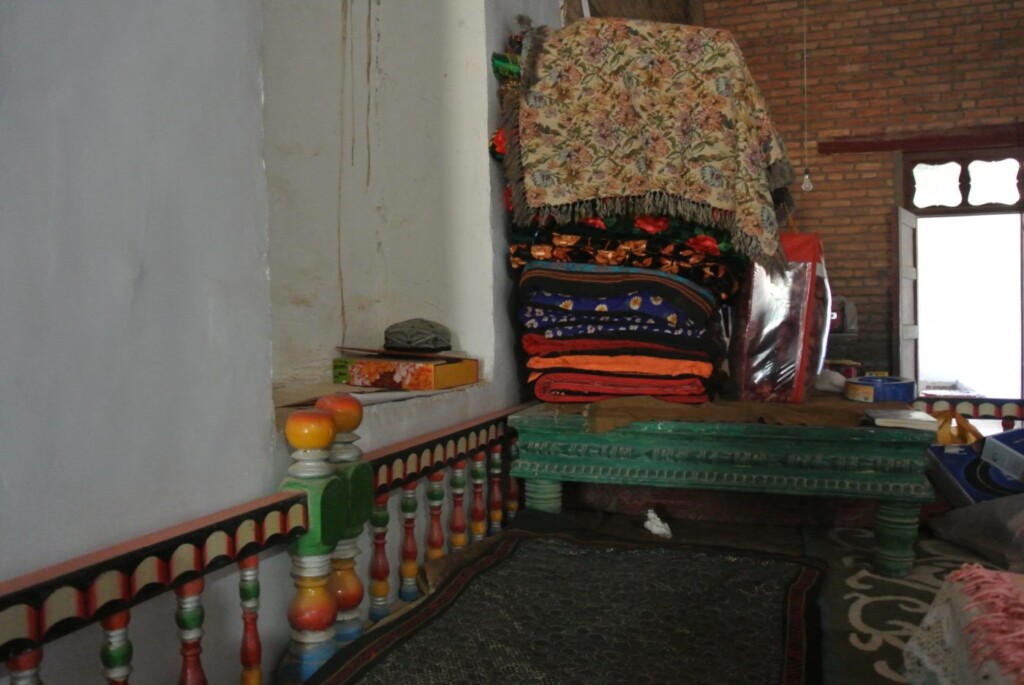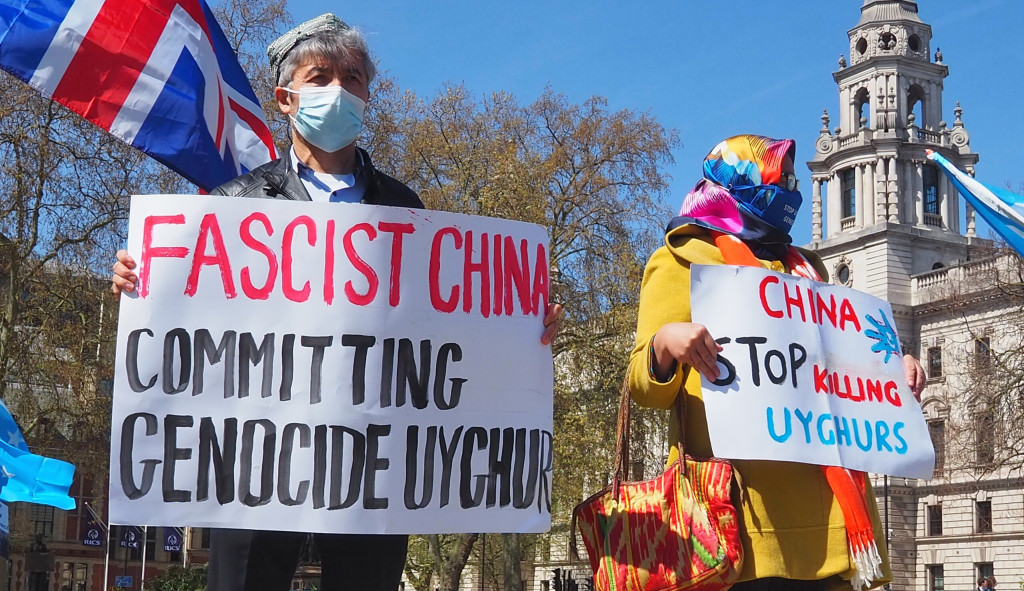22 April 2021: Demonstrators hold placards in Parliament Square. Editorial credit: Brian Minkoff / shutterstock.com
The ongoing Uyghur genocide remains a grave concern, as perpetrated by the Chinese regime through numerous crimes against humanity in East Turkestan. And despite the constant stream of new evidence and documentation, the Beijing regime strongly denies the occurrence of this genocide.
Leveraging its economic and political influence on the global stage, the Chinese Communist Party (CCP) is systematically carrying out the Uyghur genocide while skilfully manipulating public opinion. By incarcerating millions of Uyghurs in concentration camps, the CCP is actively eradicating all traces of Muslim and Uyghur culture in East Turkestan.
Sinicisation attempts continue
Under the leadership of Xi Jinping, the CCP is forcing through with efforts to Sinicise the Uyghurs, replacing their religious beliefs with the tenets of the communist system.
This aggressive campaign continues to involve the illegal settlement of Han Chinese immigrants, the enforcement of totalitarian laws, and the setting up of digital and surveillance walls in East Turkestan.
Even the family homes of Uyghur and Kazakh Muslims — intended to shield them from the oppression of the Chinese regime — are not spared from this eradication.
This article explores the multifaceted aspects of the regime’s persecution from various perspectives.
Resisting erasure: Uyghur homes as battlegrounds for cultural survival
As a significant number of social scientists unanimously agree, the perception of space goes beyond its physical dimensions, extending to an emotional connection and the ability to interpret and express feelings through spatial transformations.
Through space, that is the öy (home in English), people form identities at the individual, group, community, and cultural levels. [1]
In the process of identity formation, both the dynamics of domestic relationships and the architecture of homes are important. Specifically, the architecture of Uyghur homes in East Turkestan is a reflection of the cultural values and beliefs of the Uyghur people.
From the garden, where the guests are first welcomed, to the supa (platform in English), a space where all room doors converge, these architectural features aim to foster the religious and national identities of Uyghur children raised within such homes.
It is for this reason that the Chinese regime not only seeks to eradicate millions of Uyghurs in concentration camps, but it also makes the families they left behind the target of its toxic indoctrination.
Today, when we look at the houses in cities left over from the Soviet Union era, we see structures that are devoid of aesthetics, characterised by multiple stories, dim lighting, and reminiscent of military buildings.
This architectural style does not stem from a lack of architectural skill within the regime of that period; rather, it was a deliberate attempt to shape the identities of individuals, who were regarded as soldiers of the Communist Party, by subjecting them to a uniform military order.
Today, the CCP has resurrected this deeply inhuman system in East Turkestan.
The supa: a symbol of Uyghurness targeted by China
Professor Timothy A. Grose, an expert in China Studies, has revealed a distressing method employed by the Chinese regime to systematically eradicate the Uyghurs through the demolition of their homes, which represents a vital aspect of East Turkestan’s settled culture: the demolition of traditional Uyghur homes.
At the core of the Uyghur household lies the supa, a raised platform approximately 40- to 50cm (16 to 20 inches) above ground level, where both family members and guests gather. This central space hosts many significant activities, from wedding celebrations to the naming of children. It also serves as a place for family members to learn about their traditions and cultural heritage and to adopt them into daily life.
Moreover, the supa has another pivotal section known as mehrab (niche in English), which houses religious books, including the Qur’ān, the holy book of Islam.
In the construction of Uyghur neighbourhoods, houses are deliberately built around mosques. The mehrab area also serves as a classroom where parents teach their children religious and cultural knowledge within the familial setting.

In short, religious and cultural life within Uyghur homes, with the supa as its focal point, plays a paramount role in preserving the Uyghur identity. This is why, in line with its genocidal policies in East Turkestan, the Chinese regime is demolishing Uyghur homes and dismantling traditional structures.
The supas within these houses are destroyed, often with the alleged assistance of Communist Party representatives. And in their place, modern-style halls are built, and traditional Uyghur furniture is replaced with identity-less European-style furnishings.
Families whose houses are deemed not suitable for renovation face forced demolition and subsequent relocation to apartments. Moreover, those who object to this replacement programme are immediately labelled as radicals and sent to concentration camps. [2]

China’s “Three News” campaign
Along with the physical destruction of Uyghur homes, Chinese dictator Xi Jinping has also ordered the eradication of Uyghur culture.
Under the auspices of a campaign dubbed “Three News”, Uyghurs are coerced into unwavering loyalty to the Communist Party.
The three pillars are to:
- Thank the Party
- Listen to the Party
- Follow the Party.
This campaign further prohibits Uyghur and Kazakh Muslims from naming their children, performing circumcisions, or organising weddings and funerals.
Disturbingly, during the period encompassing Professor Grose’s research, it is estimated that over 300,000 Uyghur homes were converted into the Communist Party system through these measures. [2]
“Pair Up and Become Family” programme
Assigned “relatives” are yet another tool employed by the Chinese regime to assert control over Uyghur homes.
In October 2016, Beijing introduced a new method of repression called the “Pair Up and Become Family” programme. [A3] Under this monstrous scheme, millions of civil servants are assigned to reside in Uyghur households for a minimum of five days every two months. [3]
Reliable sources have shared with Radio Free Asia an account from Yengisar County in Kashgar, East Turkestan, where Uyghur families have witnessed an influx of Chinese individuals, predominantly men, occupying their homes.
These “relatives”, who are appointed to allegedly assist the families, propagate the ideals of the Chinese regime during their stays.
State-sponsored gang rape
At night, these CCP officials share the same bed with the Uyghurs, sometimes even accommodating three people under the pretence of cold weather. These officials also engage in meals and other activities together. [A3]
Certainly, the situation is particularly challenging for single women whose husbands have been detained in concentration camps.
Zumrat Dawut
A fortunate survivor of the Uyghur genocide in East Turkestan, Zumrat Dawut summarised the experience by explaining that families are obliged to project an air of happiness. Any deviation from this would be perceived as opposition to the so-called kin programme.
According to Dawut, instead of behaving as guests, the so-called relatives persistently monitored family members, asking questions and documenting their movements.
For this reason, Dawut had to instruct her children on how to answer, in case they were asked if their parents prayed — an extremely dangerous question if answered in the affirmative.
Qelbinur Sidik
Another victim of the concentration camps, Qelbinur Sidik, reported an incident where the assigned “relative” visiting her household was drunk and attempted to share a bed with her. [4]
The Campaign for Uyghurs, in its report on the Uyghur genocide, assessed this inhumane persecution as a systematic destruction of the family structure and home life in East Turkestan.
They revealed,
“Han Chinese cadres visit Uyghur homes at least once every two months, staying for approximately a week. During their presence, the Chinese Communist Party relentlessly spreads its propaganda while simultaneously conducting surveillance.
“These visits include encouragement of activities forbidden in Islam, such as consuming alcohol and pork. Uyghurs who prefer to purchase halal meat or refrain from alcohol are viewed as suspicious and subsequently sent to concentration camps.” [5]
Rushan Abbas, the Executive Director of the Campaign for Uyghurs, emphasised,
“The most dangerous aspect of this ‘Pair Up and Become Family’ programme is that women whose husbands are detained in the camps are forced to share beds with Chinese men. This ultimately leads to government-sanctioned gang rape.” [6]
Tech-driven oppression: the extent of Orwellian surveillance in East Turkestan
To eradicate not just the Uyghur Muslims and Turkic peoples of East Turkestan, but also the very last traces of them, the Chinese regime has implemented stringent measures, such as the prohibition of public Islamic practices.
The regime heavily implements the Big Brother surveillance system depicted in George Orwell’s renowned novel, 1984. Under this system, Beijing actively encourages residents to report on their own neighbours.
Taking this invasive approach further, the CCP has introduced the “10 households, one unit” system, which provides a legal framework for Uyghurs to monitor their own relatives and neighbours.
The Beijing regime, which has installed advanced technology systems that monitor streets, shopping centres, and every moment of daily life, has even recorded the knives used in the kitchen and collected all the identity information of the users.
And by employing the Integrated Joint Operation Platform (IJOP) data amalgamation system, even the manner in which people walk on the streets is scrutinised as a potential threat. In the Aksu region alone, 2,000 Uyghurs who were deemed a threat by this system have been detained. [3]
Attacks on the sanctity of parenthood through forced marriage
Given the paramount influence of parental education on a child’s development, it becomes evident that the Chinese regime has employed an additional strategy that targets the fundamental family structure.
This strategy involves the forced marriage of young Uyghur Muslim girls to Han Chinese men. The American anthropologist Darren Byler emphasises that while young Uyghur Muslim men are sent to concentration camps, the remaining Uyghur girls are forced to marry Han Chinese individuals who are affiliated with the Communist Party.
This means that forthcoming Uyghur generations will be raised in an environment that deviates significantly from the traditional East Turkestani household structures, resulting in the deprivation of their religious and cultural education.
It is no doubt that the ultimate goal is to turn the Uyghur people into conforming Communist Party members. [6]
Indoctrination of children through forced enrolment in Chinese boarding schools
Another group targeted by the Chinese regime in the genocidal extermination of the Uyghur population is the children of East Turkestan.
A report published by the New York Times on 28 December 2019 revealed that approximately 500,000 non-Han Chinese children were forcibly enrolled into public boarding schools under the control of the CCP.
According to research, there were just short of 900,000 Uyghur children in Chinese boarding schools in 2019, separated from family and community support. [A7]
Such schools and dorms are an important part of the cultural genocide perpetrated through the indoctrination of Uyghur children. While their parents are sent to concentration camps, these children are rounded up and placed in boarding schools where they are subjected to brainwashing based on communist ideology.
China’s official sources indicate that Beijing plans to place half a million children in boarding schools in East Turkestan and establish new orphanages in every city. The government’s goal is to convert one out of every two schools into a boarding school across all cities, starting with towns with a population of over 800.
The organisation of the Chinese regime’s boarding school system is similar to that of the military system, with strict security measures in place to restrict access to information about these institutions. The primary objective here is to erase the Muslim identity of the pupils, which Xi Jinping perceives as a form of extremism. [7]
It is impossible to fully grasp the psychological trauma suffered by these children who receive “education” under the oppressive rule of the Chinese regime. Children in Beijing’s orphanages no longer speak Uyghur or remember anything about their culture and beliefs.
For instance, when brothers Aysu and Lütfullah Kuchar, who spent 20 months in these so-called educational centres, finally reunited with their father after enduring immense hardships, their father experienced a mixture of joy and deep shock. This was due to the fact that his children could no longer speak Uyghur.
Abdullah Kuchar, the father, expressed his feelings by stating,
“One of the most challenging moments of my life was witnessing two of my children speaking Chinese in front of me.” [8]
Homes to prisons: cultural heritage erased
As summarised above, one of the most fundamental objectives of the present-day Uyghur genocide in East Turkestan is the eradication of the religious belief and cultural heritage of the people, which have long thrived within their homes and permeated through every facet of society.
This persecution becomes evident through the allegations levelled against the millions of Uyghurs sent to concentration camps.
Painting wholly innocent actions as extreme
The following examples from the 2019-leaked Qaraqash Documents shed light on this dire situation.
Tursuntohti Turdi
He was occasionally found to pray at home, attend Friday prayers, and pray after meals.
He was also found to participate in Eid prayers at the mosque.
Abdulmalik Jabbar
He was seen attending Friday prayers, and going to the mosque for Eid prayers.
Ugalnisa Metniyaz
Her husband, Ahmet Tohti Yasin, is undergoing “training” at Ürümqi Training Centre No. 3.
Before being sent to the concentration camp, he was noted to have prayed after every meal. And he used to perform one or two rak’ahs (units) of prayer at home every morning.
Rozi Eli Eziz
In 2014, he was recorded as consistently praying once every day, in addition to praying after meals.
We bear collective responsibility to aid the Uyghurs
Today, the prohibition of these practices, which are a part of the lives of individuals regardless of their religious beliefs, even within their homes, leaves the people of East Turkestan utterly defenceless against the oppression of the Chinese regime.
The sole purpose of this genocide, which has permeated every aspect of life — from the demolition of traditional Uyghur homes, to designated “relatives”, from forcibly sending children to orphanages against the consent of their families, to the forced sterilisation of women — is clearly the total destruction of the Muslim Uyghur community. It is also turning entire Uyghur homes into prisons.
The whole world, particularly the Muslim-majority countries, bears a resolute obligation to take swift action and bring an end to this appalling atrocity.
Also read
- China’s chilling use of cutting-edge technology
- Xi Jinping continues downward spiral to dictatorship
- Uyghur Tribunal underway with bone-chilling survivor testimonies
- Uyghur Muslims suffer forced sterilisation, abortions, and removal of wombs
- China’s war on Islam: Muslim women ‘forced to share beds’ with male officials
Source: Islam21c
Notes
[1] https://dergipark.org.tr/tr/download/article-file/1216517
[2] https://bitterwinter.org/uyghur-traditional-houses-destroyed-by-the-ccp/
[A3] https://www.rfa.org/english/news/uyghur/cosleeping-10312019160528.html
[4] https://www.cnn.com/2021/05/08/asia/china-xinjiang-ethnic-unity-intl-hnk-dst/index.html
[6] https://www.nytimes.com/2019/12/28/world/asia/china-xinjiang-children-boarding-schools.html
[A7] https://adrianzenz.medium.com/story-45d07b25bcad
[8] https://www.21yyte.org/tr/merkezler/bolgesel-arastirma-merkezleri/asya-pasifik-arastirmalari-merkezi/dogu-turkistan-daki-soykirim-ve-cin-den-sizan-kamp-belgeleri-karakas-listeleri

